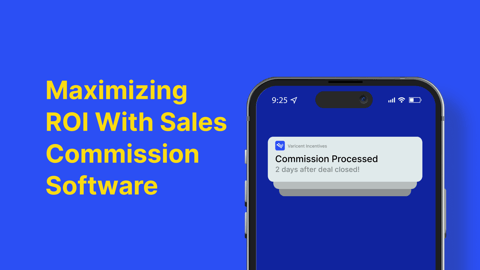Knowing how to calculate commission influences the thoughts of salespeople every day. It's where "the rubber meets the road," where all their skill and commitment get converted into rewards. Calculating commission matters to sales managers too. They need a commission structure that rewards effort and success, leading to a happy and motivated salesforce that delivers results. In this blog, we'll go through how commission works and how best to calculate it, keeping in mind the various factors that influence it.
Before diving into the details, let's look at the basics.
What is a Sales Commission?
A sales commission is how most professional salespeople get rewarded for their effort and results. Managers use commission as motivation for their sales teams to focus on the business's success. Commission can be simple or complex. It depends on whether a product has a straightforward or multifaceted sales process, the length of the sales cycle, and a product's route to market.
Understanding how to accurately calculate commission matters to everyone. Salespeople want to know the rules they need to follow to earn their rewards. They don't want to waste time focusing on business that won't attract commission. They also need confidence that their commission will be paid quickly, without needing to argue over every line item. If they can understand how much they'll earn on a deal before it's closed, then that's even better.
Managers want to know that the commission program is working well and getting the results they want. And they want to understand how it can be improved to deliver even better outcomes.

What is a Commission Calculation?
A commission calculation involves determining the timeframe within which sales are eligible for commission, usually on a monthly or bi-weekly schedule. Once the period is established, total sales are summed to form the commission base. The commission payout is then calculated by applying a percentage rate to this base. This rate may vary by the product sold or total sales volume, necessitating separate calculations for different items or sales tiers. In some cases, commissions are postponed until after the customer payment is received, and adjustments may apply if sales exceed certain thresholds, which can alter the commission rate retroactively or for subsequent tiers.
How to Calculate Commission?
Knowing how to calculate commission is important. Be accurate, transparent, and efficient. Follow these straightforward steps to accurately calculate commission, every time.

1. Determine the Commission Period
Firstly, confirm the commission period for transactions. Commission rates can change every month or quarter.
Next, confirm how much revenue in a deal will pay commission under the plan. Maintenance revenue may not be eligible, and some special contract terms, like co-term payments, may not be either. With that confirmed, check what the base commission rate is for the different components in a deal. High-margin product revenue will likely pay one rate, and lower margin services a lower rate.
3. Calculate the Payable Commission
To determine the commission amount due, apply the commission percentage to the total sales amount. For instance, a commission of 10 percent on a sale of 10,000 would result in a 1,000 commission payout.
4. Apply Any Commission Variables
Once you have the payable commission, you can apply commission variables for which a salesperson is eligible. A new customer deal might get a 20 percent uplift, as well as a standard commission. In our example, this takes the 10 percent rate to 12 percent, paying an extra $200.
5. Apply Tiered Commission Rates
In the case of a tiered commission structure, adjust the rates accordingly. For instance, a $10,000 deal concluded in Q1 may receive a 10 percent bonus, raising the commission from 10 percent to 11 percent. However, if the deal finalizes in Q4, it might not qualify for any increase, and the commission would stay at the standard 10 percent rate.
6. Calculate Any Overrides
Overrides serve to incentivize exceptional performance. For example, a standard 10 percent commission rate might increase to 12 percent if a salesperson reaches 75 percent of their annual quota.
7. Deduct Returns
Commission is usually earned upon the signing of a contract. If the customer fails to pay within 90 days for any reason, it is standard practice to retract the paid commission from future commissions on other deals, taking this adjustment into account at the period's end.
8. Split Commissions
When multiple sales representatives contribute to closing a deal, the resulting commission can be divided among them based on the company's discretion.
Remember this: the combination and sequence of these incentives matter when calculating commission. Be transparent with everyone about how all these factors work together to manage everyone's expectations better.
Factors that Influence Commission Payments
A commission plan can be simple or complex depending on the sales process and how a product is sold to an end-user. Here's a comprehensive list of factors you can use to design the perfect commission scheme for your business. You can then use it as a basis to calculate commission.
What is a Commission Basis?
The commission basis outlines the specific sales revenue that qualifies for commission payments. Under various plans, certain revenue may be excluded from commissions, particularly for products requiring post-purchase support and maintenance. Additionally, geographical sales regions are crucial since account managers typically earn commissions only on deals within their assigned territories, except in special cases where management discretion permits otherwise.
What is a Commission Rate?
A commission rate is the percentage of a transaction paid to a salesperson when they close a deal. The percentage may be fixed or variable. It might even be a defined monetary value per product sold. Whatever the arrangement, a salesperson needs to know what their likely commission is before closing a deal.
What is a Commission Override?
A commission override is an extra reward for extra effort. These kick in when an account manager has achieved a certain quota level, generally above 75 percent. Overrides incentivize successful salespeople to push for over-achievement.
What is a Commission Split?
A commission split provides shared compensation to several salespeople involved in securing a deal. For instance, if a partner assists a customer in choosing your product, both the customer account manager and the partner account manager might split the commission between them. The specifics of the commission division can differ with each transaction.
What is a Commission Period?
A commission period is the length of time – a month, a quarter, or a year – where a commission rate applies. A commission rate can vary depending on the period. A Q1 deal can have a better commission rate than a deal in Q4. That is because businesses value money in the bank earlier in the year rather than later.
Commission Structures Explained
Commission bases, overrides, splits, and periods are the building blocks of your commission structure.
Now let's look at the types of commissions that will define how much a salesperson will earn on a deal. You need to understand these fully to calculate commission.
Straight Commission Structure
The straight commission model is commission-only sales. There's no base salary; a salesperson only receives a percentage of the revenue they close.
Graduated Commission Structure
Graduated commission pays higher commission rates at higher quota achievement rates. It rewards higher achievement and overachievement to help "success breed success."
Revenue Commission Structure
Revenue commission pays a percentage of the overall sales revenue to a salesperson, let's say 10 percent. This model can apply to straight commission and base salary + commission models.
Gross Profit Commission Structure
Gross profit commission is commission paid on the profit margin of a deal rather than the revenue. For example, if there are several components to a deal, like products and implementation services, where each has different profit margins.
Tiered Commission Structure
A tiered commission structure is a compensation model where sales professionals earn commissions at varying rates depending on the volume of sales they achieve. Instead of a flat percentage, this structure rewards higher sales with increasing commission rates, creating tiers of earnings potential. As a seller reaches higher sales thresholds, the commission rate escalates, often retroactively applying higher rates to all sales or incrementally to sales beyond each threshold. This incentivizes sales representatives to exceed their sales goals, as their earning potential grows alongside their performance.

Choose Your Commission Period: Monthly or Biweekly Basis or Custom Period
Determine the commission interval—commonly a month, two weeks, or a tailored period—and tally total sales in this timeframe to form your commission base. Calculate your commission by applying the appropriate rate to the base. Adjust commission rates for different products as necessary. Introduce tiered rates to reward surpassing sales targets, thereby boosting potential earnings. A closer examination follows.
Specifying the Commission Interval
Commission payouts are often calculated based on a regular schedule, such as monthly or bi-weekly. For instance, in a bi-weekly pay structure, the commission might span sales from the first to the fifteenth of each month. In this scenario, compensation would be for sales realized from August 1 to August 15. Commissions are typically reflective of sales from the just-ended interval.
Why are Commissions the Stronghold of Any Company?
Commissions are vital to a company's sales strategy, motivating sales teams to exceed targets by rewarding performance. Utilizing cutting-edge tools, companies can tailor commission plans with real-time performance data, aligning with market shifts and individual objectives. AI and CRM systems not only predict sales patterns and streamline customer interactions but also ensure precise commission tracking and top performer recognition. This technological support enhances commission fairness, spurs revenue growth, fosters retention, and equips sales professionals to achieve both personal and company-wide sales goals.

Effective Commission Structures Increase Sales Revenue
A well-designed commission structure is pivotal in driving sales revenue, acting as a powerful motivator for sales teams. By aligning compensation directly with performance, an effective commission plan incentivizes sales personnel to not just meet but exceed their targets, tapping into their intrinsic competitive nature. As representatives push to climb the tiers of a structured commission plan, they contribute incrementally to the company's revenue. Furthermore, a rewarding structure encourages the retention of top performers and attracts high-caliber talent, both of which are crucial for sustaining and enhancing sales revenue over time. It's the clarity, fairness, and potential of a well-thought-out commission system that ensures sales teams are focused, driven, and directly contributing to the financial growth of the company.
Motivating Sales Teams and Sales Managers to Increase Sales Revenue
Motivating sales teams hinges on a mix of competitive compensation, recognition, and continuous professional growth. Clear and reachable sales targets paired with appropriate incentives drive performance, while non-monetary recognition boosts morale. Sales managers are key, providing feedback and mentorship, enhancing skills through ongoing training, and leveraging the latest technologies to streamline processes. Sales enablement tools not only improve efficiency but also focus teams on their sales goals. A combination of individual and team-driven challenges fosters a collaborative and motivated environment, propelling sales revenue upward.

Streamlined Sales Commission in Action
Mastering the swift, precise, and efficient computation of commissions is crucial for companies with sales teams. Sales professionals are more driven and high-performing when they have clear targets and trust in the compensation process for reaching those goals. Meanwhile, managers experience greater satisfaction and effectiveness when they observe a seamless, accurate, and hassle-free commission system in place.




